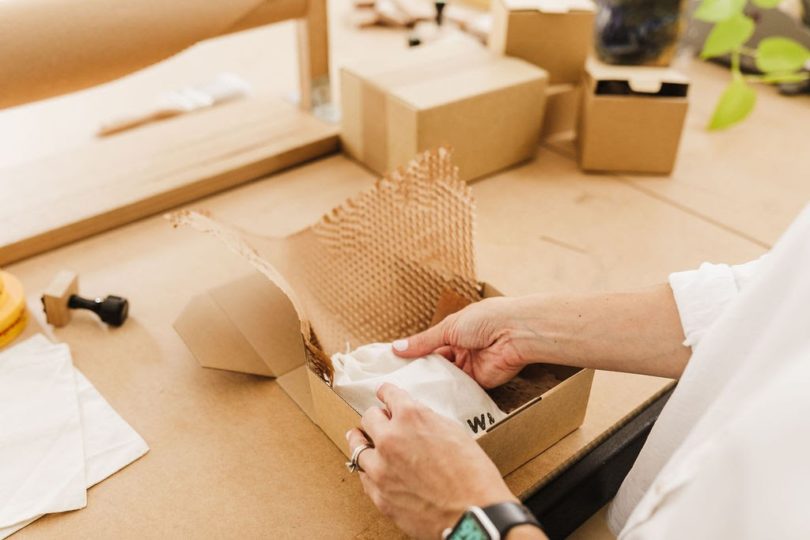In the world of e-commerce, it’s all in the packaging. Customers want a great unboxing experience when they buy your product. You’ll need to meet your customer’s high expectations, often within the constraints of a small budget.
Your packaging is the first physical touch point consumers will have with your brand, and sets the tone for their experience with your product before they even see what they’ve purchased.
For many small businesses, it’s easy to fall into the trap of overinvesting in packaging in an attempt to meet customer’s expectations. While there are certainly lots of options available for customised packaging, many require a large upfront investment, and minimum order quantities are usually in the thousands.
The good news? It’s possible to create beautiful and impactful, customised packaging with very little investment. Custom paper tape, along with rubber stamps and embossers are scalable, versatile, alternatives before you’re ready to scale up and invest in fully customised packaging.
Here are our tips for creating packaging to wow your customers without blowing the budget:
- Choose packaging that is consistent with your brand proposition
When you’re planning how to package your goods for retail or shipping, make sure you consider the impression you want to make. Is it in line with your brand proposition? The right packaging will help reinforce your messaging and deliver a consistent and positive experience for your customers.
For example, if you’re an eco-friendly brand you’ll want to be sure your sustainable values flow through in all aspects of your business, in particular your choice of packaging. This would mean minimal packaging. You could reuse packaging materials, or choose recycled materials where possible. You need to make sure your packaging materials aren’t going to end up in land-fill, so look for recyclable or compostable packaging, such as paper tape or compostable mailers.
On the other hand, if your brand personality is bold, colourful and fun, you might consider coloured tissue paper, bright stickers or a colourfully illustrated thank you card.
- Work within your budget
Custom printed boxes are great for established brands that have the volumes to justify the investment, but this isn’t the most economical option for everybody. A challenge for smaller brands is to deliver a similar customer experience without the price tag.
A great first step is using a custom rubber stamp on basic packaging. Rubber stamps are a versatile tool that can be used on virtually any flat surface. No two prints from a stamp will be the same, so they lend an authentic look and feel, they look particularly great on cardboard with the extra texture resulting in unique impressions on each box. There are loads of suppliers you can consider offering plain shipping boxes in every size you can imagine, and in small quantities. Try eBay and look for local sellers to minimise shipping costs. Get yourself a small amount of plain boxes, and a rubber stamp with your logo and you’ve got a cost effective way to ship your goods and deliver a professional, branded experience to your customers.
- Look for environmentally friendly and sustainable options
Customers respond well to brands that are taking proactive steps to be considerate of their environmental impact. This could be by rethinking packaging materials to minimise waste, or by choosing to use sustainable options wherever possible. Fortunately, there’s an increasing number of options available for packaging materials that are made from recycled materials, as well as other materials that are sustainably and ethically sourced.
Water activated paper tape sometimes needs a specialised dispenser to moisten the water-activated glue, but is a super strong way to secure packages. The kraft paper bonds with corrugated boxes and it can secure parcels weighing up to 15kg. This can be a little fiddly to use at first, but the upside of using this type of product is packaging that’s made with sustainable materials (ie not petroleum / fossil fuels) doesn’t add any contaminants in the recycling process and can be easily recycled through standard curbside recycling.
With so many choices for custom packaging, it can be difficult to know what the right option is for your brand. If in doubt, take a less-is-more approach. Prioritise materials that are functional and protect your goods in transit. Once you have that, and when budget allows, consider additional elements that may be more decorative or ‘nice-to-have’ but that add to the overall brand experience.
“The opinions expressed by BizWitty Contributors are their own, not those of BizCover and should not be relied upon in place of appropriate professional advice. Please read our full disclaimer."







